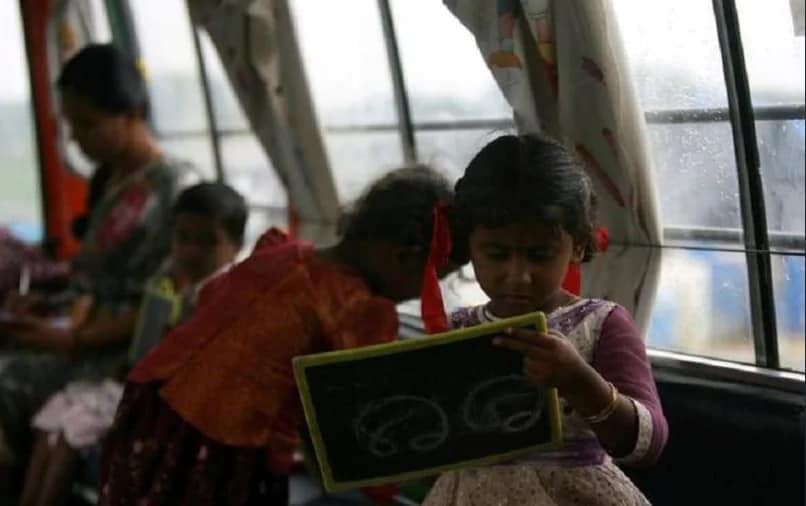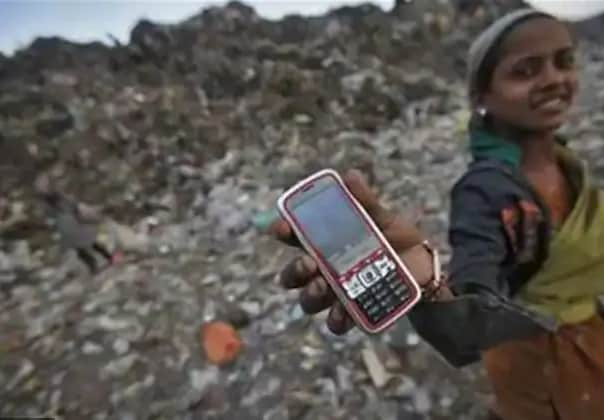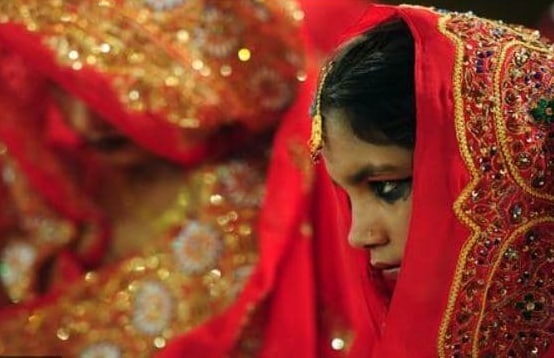In Rajasthan’s Beer village, Pinky, an eighth-grade dropout, has been preparing for her enrollment in open school examination. As the pandemic hit, the family lost all sources of income and became dependent on the ration that was provided by the Panchayat. With help from locals, they were able to get MNREGA card — their only source of income.
But when liquor shops reopened as the government started easing the lockdown rules, Pinky’s alcoholic father, who was drinking country-made liquor, beat her, her three sisters and their mother to take away the remaining money left in the house. A few days later, he sold off the gas cylinder so he could buy more alcohol. With no other income left and very little options, Pinky may not be able to get back to school.
More than 1.5 billion children are out of school due to the disruption caused by the global coronavirus pandemic. In India, schools have been shut since the end of March. While many of those schools have moved to a system of online classrooms, it means very little to Pinky and a thousand others who have only heard of the word ‘Google’.
Over a decade ago, India passed the landmark Right to Education (RTE) Act that made education free and compulsory for children between the ages 6 and 14 in 2009. The enrolment of girls in schools has increased but for many reasons, the RTE Act did not help in keeping girls in schools. The shutting down of schools has made the already difficult lives of young girls more challenging, especially in rural India.
“Girls will drop out, they will be made to drop out,” said Poonam Muttreja, executive director of Population Foundation of India. Muttreja noted that the pandemic coupled with the lockdown will be especially hard on teenage girls. “Their mid-day meals are gone, they are not getting sanitary napkins which were provided by schools, they are closed inside homes with no interaction with friends,” she said.
India also has the largest number of anaemic women in the world. With very little income and the absence of mid-day meals for young girls, battling one of the biggest health crisis will get more challenging.
Why School Will be a Fleeting Dream for Many
Earlier this month, a 14-year-old from Kerala killed herself over not being able to attend online classes because she did not have access to the internet or television. The 10th grader who lived in the Mankeri Dalit colony in Walanchery in Malappuram district had bagged the Ayyankali scholarship. Her father, a daily wage labourer, had lost his job during the lockdown and did not have the means to repair the television.
READ: Domestic Abuse Survivors are in Lockdown with their Monsters
Kerala is one of the very few states where the government is trying to intervene in the disrupted education system. But in a country where more girls are enrolled in government schools and boys in private ones, a shift to online classrooms would benefit, if at all, students in private schools. It means, most girls would be left out.
“My daughter has been sitting idle at home. We don’t have to pay the tuition fee because she goes to a government school. But how long will she sit at home? Her father has lost his job and I am the sole bread earner. I want her to study but what options do I have?” asked Rinku, a domestic help in Delhi. Her daughter is in the 7th grade. “If I find a good partner for her, maybe I will…” Rinku stops short of finishing the sentence, but her plans for her daughter’s future are obvious.
The 14th Annual Status of Education Report (ASER) for 2019, based on a survey conducted in 26 districts across 24 states in India, notes that “Gender gaps are visible even among young children with more girls than boys enrolled in government institutions and more boys than girls enrolled in private institutions.”

“If a family has a son and a daughter and they can afford to send only one of them to a private school, it’s usually the son. The daughter goes to a government school. This reflects in the quality of education that girls receive,” said Muttreja.
The ASER report notes that among children between the ages of 4 and 5, 56.8% of girls are enrolled in government schools, compared to 50.4% of boys, while 43.2% girls and 49.6% boys are enrolled in private pre-schools or schools. The difference gets wider with their age. In the 6-8 years age bracket, 61.1% of the girls attend a government school, versus 52.1% of all boys.
The pandemic has also brought forward what the landmark RTE Act had failed to acknowledge and address. The biggest reason why girls have been unable to go to schools — housework.
The burden of housework on Indian girls has been a spiralling crisis for India. “Even before Covid-19, girls in India did substantially more unpaid care work than boys. This mirrors Indian adults – Indian women have among the highest number of hours spent per day on care work (297 minutes a day) while Indian men have among the lowest (31 minutes),” said Antara Ganguly, Gender Specialist at UNICEF India.
In its 2015 report on gender inequality in India, the McKinsey Global Institute found that Indian women perform nearly 10 times the unpaid care work as men. That’s almost three times more than the global average. The 2018 report found that girls who do two hours of housework per day have a 63 percent probability of finishing secondary school.
Rinku’s 15-year-old daughter now cooks and cleans her house as her mother steps out to work in others’ houses.
“In India, girls are generally less likely than boys to transition to and graduate from secondary school. We are concerned that as Covid-19 impacts parents’ ability to invest in all their children’s education, some of these tough choices will come down even harder on girls,” said Ganguly.
READ: 1 Phone, 2 Siblings: Students Forced to Skip Online Classes
Soon after the lockdown, Saarthi Education, an NGO that works on underprivileged children’s education, designed and implemented a WhatsApp-based learning program for Nursery to Grade 5 students. Parents receive a worksheet on WhatsApp every morning. They copy out the worksheet in their child’s notebook and guide their child to complete the worksheet. They then click a photograph of the child’s work and share it with their Relationship Manager and wait for feedback on their performance.
“There is a genuine fear that children may drop out of schools because of them being shut for a long duration. Parents are cutting expenses and saving money – they are planning to enrol their child in school later on. Some may not find it valuable to pay for their child to attend school for only half a year, this might result in a longer drop out duration,” said Smruti Savkur, Founding Partner of Saarthi Education.
The WhatsApp model was chosen keeping in mind the low internet access and that most families don’t have more than one smartphone if they do.
However, Rajkumari, a community leader who works with families and children living in the Jaitpur neighbourhood of Delhi-Faridabad border, says that the partiality in how parents treat their children based on their gender is visible. “It’s always the boys who get to finish their homework first,” she said. The families who own two phones are only recharging one now with their limited earnings. “Girls are naturally at a more precarious situation,” she added.
Do Girls Have Phones and Laptops?
On the first day of June, the Kerala government had restarted classes for school students from LKG to Class XII with experimental virtual classes on YouTube and through the government-run education channel, Kite Victers. But the death of the student has highlighted the existing divide in the country when it comes to accessing online education tools. Incidentally, more than half of Kerala’s inhabitants have access to the internet, which is far higher than the rest of the country. A 2018 report by the Internet And Mobile Association of India also showed that the state has among the highest rates of internet use by women.
Across the country, the same report noted, that there are 143 million women internet users, which is approximately only 30 percent of the total Internet users; 70 percent of the Internet users are men.
According to the Key Indicators of Household Social Consumption on Education in India report, based on the 2017-18 National Sample Survey, less than 15% of rural Indian households have internet (as opposed to 42% urban Indian households). A mere 13% of people surveyed (aged above five) in rural areas — just 8.5% of females — could use the internet. The poorest households cannot afford a smartphone or a computer.

India’s stark gender digital divide was pointed out by the 2020 GSMA Mobile Gender Gap report that noted that women are 20 per cent less likely to use mobile internet than men. It also noted that more than 300 million fewer women than men access the internet on a mobile, particularly in South Asia at where that gap is at around 51 per cent. This gap is even higher in rural areas.
“Parents still do not want their daughters to use smartphones because they are worried about what they believe might be negative consequences of the freedom it might bring them,” said Ganguly.
Shabnam Aziiz, project leader for Adolescent Girls Programme that is a part of the NGO ‘Educate Girls’, says that most girls in rural India are not allowed to use phones in the fear that they will ‘taste freedom’. It’s not unusual for families to fear giving out mobile phones to their daughters as even lawmakers in Karnataka have blamed mobile phones for the sexual violence against women.
A report tabled in the Karnataka Assembly by the state’s Women and Child Development Department in 2014 read, “There were several instances where mobile phones were used to lure girls to remote places and rape them. Mobile phones are debasing the educational atmosphere in schools and colleges.”
Eighteen-year-old Seema from Nawab village in Rajasthan attempted suicide by consuming poison after her brother slapped her for using her cellphone ‘very frequently’. Seema, a class 8 dropout, was forcibly withdrawn from school so she can help in domestic chores. The family had purchased a mobile phone for use at home. During the lockdown, as Seema’s brother and father stayed home, they observed that she was using the phone. The abuse and violence began soon after and had it not been for quick treatment, Seema wouldn’t have been alive.
When Seema got slightly better, her family sent her back to her husband’s house. Everyone in the village found out. Families of three other younger girls in the village sent their daughters back to their abusive in-laws fearing losing honour if they get ‘influenced’ by Seema.
Will Child Marriages Increase?
In Odisha’s Nayagarh district, a month after the lockdown, 16-year-old Soubhagyabati’s father, a daily wage labourer, decided to get her married off to a 26-year-old man, a truck driver. With frontline workers busy with the pandemic crisis and the lockdown, he thought he could conduct the marriage without the authorities knowing. The wedding, he thought, would also cost less as the social distancing rules meant he would have to invite only a few guests. Soubhagyabati’s friend, who worked at the Anganwadi centre with her, came to her rescue with a call to the childcare helpline.
There was a dramatic upswing in child marriages and trafficking following the Nepal earthquake in 2015. After the Ebola crisis, the number of girls who dropped out of schools almost tripled in countries that suffered. Following the 2004 tsunami, girls in Indonesia, India and Sri Lanka were forced into marriage with tsunami widowers and in many instances did so to receive state subsidies for marrying and starting a family. In Bangladesh and northeast India, there’s enough evidence to show that increased extreme poverty provoked by river erosion and floods often push families to adopt child marriage as a survival strategy.

Worldwide, an estimated 12 million girls are married every year before the age of 18, which amounts to nearly one girl every three seconds. Last month, the UN warned that the pandemic could lead to an extra 13 million child marriages over the next decade.
“Many girls won’t return to school because they will be kept at home for caregiving, domestic work, farm grazing and marriage. Child marriage will increase exponentially as families already see girls as a liability and getting them married off will mean one less mouth to feed,” said Safeena Husain, founder and executive director at Educate Girls.
An additional four million girls are at risk of child marriage in the next two years because of the coronavirus pandemic, a report by global charity World Vision has warned, as deepening poverty is likely to drive many families to marry off their daughters. The report also warns that up to 85 million children face physical, sexual and emotional violence at home and in their communities over the next three months as the financial and emotional pressures of the pandemic worsen.
One of the many ways that the government can encourage girls to go back to school, Hussain feels, is to address safety. “The government needs to ensure girls who are above 10-12 years who are at a higher risk of child marriages in particularly high-risk areas have hostels to live in. They need to invest in setting up places for girls to stay,” she said.
READ: What Coronavirus Lockdown Means for India’s Mental Health
The other crisis that needs to be solved is hunger. “It can be take-home ration or meals in schools, but hunger has to be addressed for children to go back to school,” she added.
The founder of Educate Girls also said that policies which take care of girls’ mental health especially if they have lived inside homes for so long and faced domestic violence should be taken up seriously. “There should be no pressure on girls to finish the course — a shift in transitional learning has to happen,” she added.
While the government is mulling a staggered reopening of schools gradually, a 15-year-old Manashi in Subarnpur district of Odisha was married off in late March because her father wanted to reduce the number of mouths to feed. When the Child Marriage Prohibition Officers found out, they brought back Manashi from her in-laws and sent her to her parents’ home. When she turns 18, the parents will send her off. Manashi won’t go back to school.
https://pubstack.nw18.com/pubsync/fallback/api/videos/recommended?source=n18english&channels=5d95e6c378c2f2492e2148a2&categories=5d95e6d7340a9e4981b2e109&query=Pulled,Out,of,School,,Pushed,Into,Marriage:,What,the,Pandemic,is,Doing,to,India’s,Teenaged,Girls,child,marriage,Coronavirus,and,education,&publish_min=2020-06-10T10:05:58.000Z&publish_max=2020-06-12T10:05:58.000Z&sort_by=date-relevance&order_by=0&limit=2

